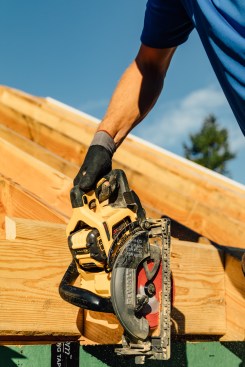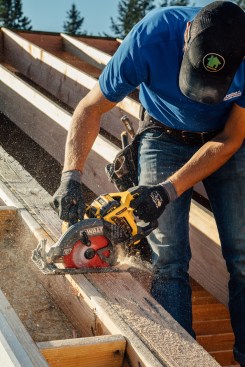Tim Uhler
In June, I reviewed the Makita rear handle cordless saw and gave it rave reviews. We had been using cordless saws for years but hadn’t completely gone cordless prior to that simply because the cons of cordless (less runtime and power) outweighed the pros (mobility and no trip hazards, just to name a couple). In August, DeWalt announced its version at the annual media event: a 60V Flexvolt cordless rear-handle saw, which I was able to review.
This is a blade-left, rear-handle saw that takes a single 9-Ah or 6-Ah 60V Flexvolt battery; DeWalt calls it a “wormdrive style” saw. It does not have a wormdrive motor, but it looks similar to the Skilsaw wormdrives that have been commonly used by framers here on the West Coast since the 1950s.
Features. The battery sits right behind the motor and in front of the handle, keeping the weight relatively centered, which results in a balanced saw. The saw bevels to 53° and just barely cuts through 2-by material at that angle. It has positive stops at 45° and 22.5°. The cutting depth matches most 7 ¼-inch saws at 2 ⅜ inches (the cutting depth of the Makita is 2-9/16 inches).
The magnesium baseplate offers an incredible line of sight when the saw is tilted to cut bevels. While I like that feature, I find that the baseplate “sticks” a little when I start a cut. I often enter a cut with the saw tipped up slightly so that I’m starting with just the front edge of the baseplate on the material. This saw’s baseplate is not rounded over enough, so the start is not as smooth using my usual method. Not everyone starts a cut this way, but it was noticeable enough for me that I needed to adjust my method slightly. The rafter hook is basically perfect: not too big, but big enough to hang off 2 ½-inch I-joists.
I have come to love blade brakes, and this DeWalt has an electronic brake that works well. This is a safety feature I believe should be on every saw. The guard never once snagged when we made cuts, even when making compound miter cuts for jack rafters. A guard that works so well that you don’t realize it’s there because you’re not fighting it is a real plus in my world.
Another feature that I liked is the dust port, which is on the side of the upper guard. It shoots a lot of sawdust as you cut. We taped the port up because the way it’s oriented puts dust all over the cut area, obscuring the cut line. But I like having it because it gives us the option to hook up a vacuum with an attachment–something we’d do for interior demo work or the like, though not when framing outside.
Power. This saw has loads of power. It is a beast and spins the blade fast (To compare: the DeWalt runs at 5,800 rpm, the Makita runs at 5,100 rpm, and the corded Skilsaw runs at 5,300 rpm). The faster rpm translates to faster cutting, and this motor easily powers through LVL, even ripping LVL or cutting compound miters through LVL. I think this is the most powerful 7 ¼-inch saw I’ve ever used, and if that is what you need, this is your saw.
Runtime. The big question with cordless tools is runtime: How much work can you get done on a single, fully charged battery? With some tools and in some applications, it’s unlikely that you’re going to be able to outwork a battery before a second one is fully charged, so runtime is a non-issue if you’ve got two batteries on hand. That’s not the case here, because we’re talking about a framing saw that typically sees frequent use.
On some days, when we were doing pickup framing and siding, we could use the saw all morning and put the battery on the charger at lunch and never run out of battery. The 9-Ah battery takes 81 minutes to charge (I timed it from zero). We can easily drain a battery in that time frame if we are doing a lot of ripping or cutting stair stringers, for example. When we were cutting siding (with a lot of ripping and gang cutting), we got about 2 hours out of one battery.
If you’re a framer hoping to use this saw all day long, I recommend having three 9-Ah batteries on hand so that you never have downtime. You could get away with having just two most of the time, if one is always charging, but if you have a heavy cutting day–for instance, cutting stairs or rafters–a third battery would be best.
Is It Worth Buying? I found this kit with one 9-Ah battery on Amazon for $400. Skip Amazon and look for deals that offer a free battery, like this one at ToolNut (offer ends December 31, 2017).
One factor to consider is that going cordless means you don’t need expensive cords. We always run 100-foot 12/3 15-amp cords, which run about $75 each. They get nicked, the ends go bad, and depending on your company policy, they may need to be taken out of service if there is any damage to the cord. Then there is the roll-out and roll-up time, time down due to the power tripping if too many people are running tools off the same circuit, and so on.
For us, we have only one power cord rolled to the job (besides the one to the van to power the chargers). This means less time wasted with cords, more room in the van, and a safer site. I cannot oversell the convenience of cordless tools like this.



